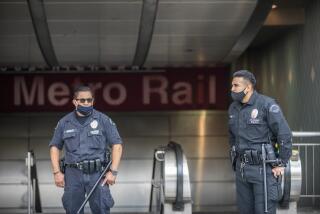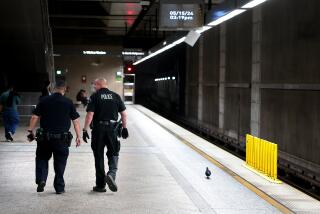Metrolink chief gets the railroad back on track
- Share via
When John E. Fenton took over Metrolink in April of last year, the government-run railroad had fallen off the tracks.
Several million dollars in inventory was unaccounted for. Ridership was declining and staff morale had plummeted. After a head-on crash with a freight train in Chatsworth killed 25 people in 2008, the line had the worst safety record in the nation for a commuter railroad.
Today — 16 months after Fenton arrived — Metrolink has changed by a number of critical measures.
Transportation officials say the 52-year-old chief executive has reversed the line’s sagging performance under David R. Solow, who stepped down as chief executive in December 2009 during a management shake-up.
Safety violations and injuries have decreased. On-time performance has risen. Ridership has increased by about 5,000 a day since December, and millions of dollars have been saved through changes in procedure.
Audit recommendations that languished for years under Solow have been accomplished in months, if not weeks. To promote the railroad, Fenton has tapped into social media like Facebook and Twitter. He also has expanded operations, with novel approaches like service to a U2 concert in Anaheim one weekend last month. It attracted about 11,000 riders.
“There was a very dispirited group at Metrolink after the Chatsworth crash,” Fenton said. “The railroad had forgotten its purpose. Everyone needs to realize that we don’t move trains. We move people.”
The challenges before him remain considerable. Fenton notes with dismay that in a region with more than 14 million people, Metrolink hauls only about 21,000 round-trip passengers per day. The number of individual boardings peaked in July 2008 at more than 50,000 per day, but ridership plunged to 37,347 before rising again in December.
And because Metrolink must share its track with major freight lines and cross against truck and car traffic at more than 400 street and highway intersections, the risk of a collision is always present.
In charge of a five-county system with 512 miles of track, Fenton regularly puts in 12- to 14-hour days for his $275,000 annual salary. He constantly measures performance, talks up safety and shows a fervent desire to better serve customers.
“I try to create an environment where people feel valued, where they can take ownership,” Fenton said in a recent interview. “Goodness is what motivates people. People long for being part of something successful.”
Except for stints in investment banking and waste management, Fenton is a longtime private-sector railroader, having held high-ranking executive positions at four major lines. He has degrees in transportation and systems management.
Shortly after he was hired, Fenton’s deliberate style drew some concern from Metrolink board members — 10 mayors, county supervisors and transportation officials from across the region — who felt they were not being adequately informed. But supporters say he quickly adapted.
Where Solow was guarded and media-shy, Fenton is at ease in front of a camera. His modest frame is topped by a round, boyish face, with sandy hair and wire glasses, and he speaks with a slight Midwestern drawl.
His view of human relations was partly shaped by his father, a Church of Christ minister in Bloomington, Ind. “He once told me that people might forget what you say or do, but they will never forget how you make them feel,” Fenton recalled.
Inside Metrolink, that approach has been refreshing.
Within six months of his hiring, he bolstered morale with an event at the Pasadena Playhouse. An open microphone was set up so employees could talk about Metrolink and the effects of the horrific Chatsworth crash. It was part wake, part therapy session.
“It was the start of a turnaround in the culture of the railroad and provided an outlet for employees to grieve and express their concerns,” recalled Richard Katz, board chairman of Metrolink’s operator, the Southern California Regional Rail Authority.
In one of his first changes, Fenton stopped engineers from having their locomotives idle without reason, sometimes for hours a day. It has saved Metrolink more than $3 million in fuel costs.
With a small boost in the operations budget but without increasing crews, he added 22 trains to Metrolink’s schedule.
The new service included an Antelope Valley express line, more holiday trains and special-event transportation to baseball games, concerts and high-volume destinations, such as the San Manuel Indian Bingo & Casino in San Bernardino.
The casino train attracted 3,000 riders a week until it stopped when the casino said it could not provide enough shuttles to get passengers to and from the Metrolink station.
Complaints from the public, passenger counts, mechanical problems, crimes, safety violations and the number of late trains are now tallied daily and discussed at 7 a.m. briefings Fenton regularly attends at the Pomona operations center.
“He realizes the train is a lifeline for people,” said Bart Reed, director of the nonprofit Transit Coalition and a member of a special review panel appointed after the Chatsworth crash. “Metrolink is a different planet.”
Under Fenton’s leadership, the number of rules violations by train operators and other railroad workers has decreased from 33 in 2010 to 12 — a telling measure, because the Chatsworth crash was blamed on a distracted engineer who had been text-messaging just before running a red light.
Richard Clark, a top safety official with the California Public Utilities Commission, praised Fenton and said that Metrolink has, at least for now, virtually eliminated red-light violations by train crews.
Fenton has boldly vowed that by early 2013, Metrolink will also be the first railroad in the nation to install a sophisticated collision avoidance system that might have prevented the Chatsworth crash. Many in the rail industry say it is a substantial challenge because so-called positive train control has yet to be demonstrated on a large scale.
But the tone set by Fenton may be Metrolink’s most significant change.
“With the help of the board, Fenton broke up a good ol’ boys network and brought a fresh and invigorating purpose to the agency,” said Keith Millhouse, a Metrolink board member who has worked to reform the railroad.
Millhouse said that Solow had created a “silo culture” in which managers ran their own fiefdoms and no one challenged the status quo because the system worked for them but not necessarily for Metrolink.
A few months after the Chatsworth crash on Sept. 12, 2008, a Metrolink peer review panel uncovered serious management deficiencies, a lack of oversight, low morale and safety problems under Solow’s stewardship.
But efforts by board members to oust the former chief executive were unsuccessful until he stepped down more than a year after the crash.
“I really thought the railroad was on the ropes,” Katz said. “We needed someone who could not only run Metrolink but turn it around. A few minutes into our interview with Fenton, we knew we had the right guy.”
On a recent morning, Fenton demonstrated his management style by boarding a train from Pomona to Los Angeles to hear what riders thought about his railroad — something he has done regularly.
“Hi. I’m John Fenton, CEO of Metrolink. Is the train trip doing OK for you?” he asked a U.S. Army veteran wearing a dark green beret with the insignia of the 1st Infantry Division, the famed “Big Red One.”
“The train is clean and the people are friendly,” the former soldier answered.
“You need to listen to what people have to say and hear what they have to say,” Fenton said. “The people have told me that they are scared of Metrolink. That the system is difficult to figure out.”
To encourage ridership, Fenton and his staff are reaching out to companies and overhauling the marketing effort. Metrolink also has begun placing so-called customer engagement representatives on trains to assist passengers and take complaints.
“I knew this would be a major turnaround effort,” Fenton said. “But that’s what I love. Go in and see how you can make things better.”
More to Read
Sign up for Essential California
The most important California stories and recommendations in your inbox every morning.
You may occasionally receive promotional content from the Los Angeles Times.
![Irvine, CA - July 16: Gina Osborn, shown at her home, is the former head of Metro security is suing the agency for firing her after she filed a claim with the Inspector General. Photo taken at her home Tuesday, July 16, 2024. Gina Osborn, a former FBI agent who was the agency's first chief safety officer, "was summarily terminated by [Chief Executive] Stephanie Wiggins," said her attorney, Marc R. Greenberg. Osborn says in claims that she butted heads with Metro's CEO over security as the agency was trying to put a good face on its efforts to clean up crime and loitering. (Allen J. Schaben / Los Angeles Times)](https://ca-times.brightspotcdn.com/dims4/default/c1419ae/2147483647/strip/true/crop/5981x4000+9+0/resize/320x214!/quality/75/?url=https%3A%2F%2Fcalifornia-times-brightspot.s3.amazonaws.com%2F46%2F07%2Fa88ac0b7466895ee4e137839d93c%2F1467168-me-former-metro-security-chief-18-ajs.jpg)










